<<PREVIOUS -
HOME -
CONTENTS -
NEXT>> -
![]()
<<PREVIOUS -
HOME -
CONTENTS -
NEXT>> -
![]()
Imaging the Sky Conference 2013
Portland-Hillsboro, OR 97124 USA Updated on April 14, 2013 Work-in Progress Schedule |
|
|
|
||
|
||
|
||
|
||
|
||
|
|
|
|
|
|
|
||
|
||
|
|
|
|
|
|
|
|

Richard Berry is an author, editor, and software programmer focused primarily on amateur astronomy. His books include a classic, Build Your Own Telescope, a popular introduction to observing, Discover the Stars, the acclaimed manual for big Dobs, The Dobsonian Telescope (with David Kriege), and the book best known to NEAIC attendees, The Handbook of Astronomical Image Processing (with Jim Burnell), which includes the Astronomical Image Processing for Windows (AIP4Win) software widely used for image processing as well as both photometry and astrometry. At age 13, Richard built his first telescope (a 6-inch f/7 Newtonian) and moved on to construct an 8-inch f/10 planetary telescope, a 6-inch RFT, a 12-inch f/7 Newtonian, and an 8-inch Dall-Kirkham Cassegrain. He observed all of the planets, most of the Messier objects, and made deep inroads into the NGC catalog. In those distant days of darkroom chemistry and bromide paper, he specialized in lunar and planetary astrophotography. After majoring in astronomy for his B.A. degree, Richard went on to present a thesis on photoelectric photometry earning an M.Sc. in astronomy. In the technology world, he has designed rocket payload instrumentation, measured air pollution (ozone and hydrogen sulfide) using a laser beam, and tested key components for the Ultraviolet Absorption experiment (MA-059) flown aboard the Apollo-Soyuz Test Project. Switching from technology to editing, Richard served a ASTRONOMY magazine's Technical Editor, then Editor, and finally Editor-in-Chief, for sixteen years, and played a key role in building the fledgling magazine's circulation from 38,000 in 1976 to its peak at 252,000 in 1988. During his years at ASTRONOMY, Richard built a strong, effective, and knowledgeable editorial staff, and worked tirelessly to ensure that manufacturers present only honest and accurate claims in their advertisements. During his years at ASTRONOMY, Richard founded and edited Telescope Making, a quarterly magazine devoted to the community of amateur telescope makers. From 1978 through 1991,Telescope Making introduced its readership to the Dobsonian telescope, the Poncet platform, tilted-component telescopes, and many examples of outstanding amateur observatories.
From 1992 to the present, Richard has written and coauthored a string of books about telescope making, imaging with CCD cameras, and image processing. He has given countless talks and participated in workshops at conferences around the world. His current book, due out this summer or fall, is a comprehensive ray-trace analysis of the telescope, eyepiece, and astrographic camera designs available to today's amateur astronomer.
|
|
|
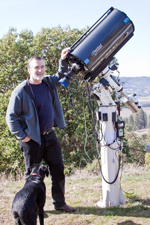
Sean Curry lives in the beautiful Wagner Valley in Southern Oregon. He got his first telescope upon moving there in 2002, and began imaging with a modified DSLR in 2006. Sean's imaging eqipment now includes an AP900 Mount, a Tak FSQ106, a PlaneWave CDK 12.5, and a QSI 583wsg camera. Sean enjoys the processing component of astro imaging, and spends a lot of time digging into PixInsight. He supports his astronomy hobby as a Lecturer in GIS at Southern Oregon University, and as a researcher at the University of the Pacific. |
|
|

Duncan Kitchin
Duncan Kitchin has been taking astro images since 2003, starting with a
point and shoot digital camera. Since 2005, he has been capturing deep sky
images with a modified DSLR and various telescopes, switching more recently
to a dedicated CCD camera. His current interests include capturing
narrowband images from his back yard in heavily light polluted Beaverton. |
|
|
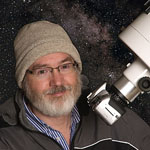
Greg Marshall has been an amateur photographer for some 40 years and started doing astro-photography in 2005. His professional career as an electronics engineer has mostly been involved with image capture, processing and printing. He now operates a small business selling astro-photography prints and tools for astronomy. |
|
|
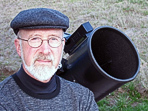
Ken Hose
Ken Hose has been active in visual astronomy for the last 10 years or so. He now has an observatory and taken up astro-imaging. As an engineer, he has an interest in the scientific aspects of the hobby and has a special interest in detecting exoplanet transits. |
|
|
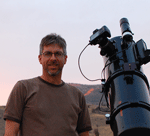
Craig grew up in a small town in northern British Columbia. He became interested in astronomy at an early age. In fact, he remembers memorizing facts about planets almost as soon as he could read. As he grew older, however, he became more interested in other pursuits -- some academic, some not quite so much -- and did not seriously return to the hobby until after he got high school, university, his first job, marriage, and kids all squared away. In 2008 he received a telescope for Christmas from his better half (who had no idea what she was getting herself into), put a camera on it and was hooked. Since then he has found astrophotography to require a blend of artistic and technical discipline that deeply appeals to him. As an added bonus, the hobby has introduced him to the wild splendor of central Oregon, and he has met many fascinating and knowledgeable people he would never have otherwise. He pays for his hobby by spending his daylight hours as the quality assurance manager for a steel mill.
|
|
|
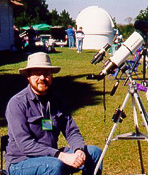
David Haworth enjoys astronomy imaging and processing those images to bring out details that cannot be seen easily by visual observing with the same size optics. David Haworth started astroimaging with a Cookbook CCD camera he built in 1996 and since then has used many types of cameras to image the sky. David wrote Chapter 2: "Afocal Photography with Digital Cameras" in the second edition of "The Art and Science of CCD Astronomy" which was published in December 2005. David's images have appeared in magazine front covers, articles, books, catalogs, videos, music CD covers, T-shirts, other web sites, etc. |